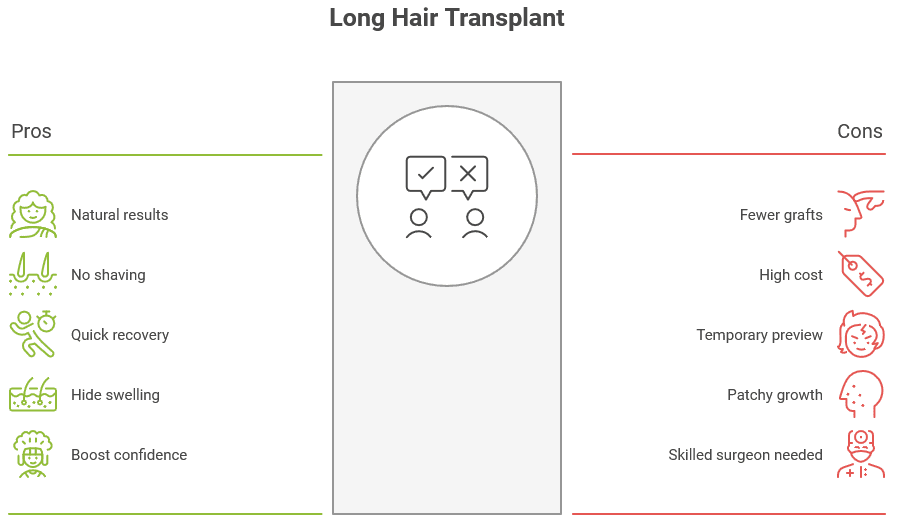Women and men with longer hair can have significant confidence issues when they start going bald or experience thinning, as their hairstyle is a big part of their self-image. There is also the psychological shock of having their donor and recipient area shaved during a traditional Follicular Unit Extraction or FUE procedure.
However, there is no need to worry, as there is a no-shave variation, also known as the long hair transplant. We will review all the details on how it works, what makes it unique, and how to tell if you are a good candidate.
How Long Hair Transplant Works
Unlike the standard FUE technique, where the hair is first cut or shaven, in the long hair method, the follicles from the donor area are extracted while the strands are at their full length, up to 25 cm. The doctor will then make tiny incisions in the recipient site and implant the donor strands alongside the existing hair without disturbing the overall style and shape.
That way, you get to see what the final result will look like right after the procedure, instead of waiting for at least six months like with traditional methods, and get a very natural look. However, the transplanted hair will still enter the exogen or shedding phase in two to four weeks and start falling out before growing back stronger in six to eight months after the operation.
Key Differences vs. Regular Hair Transplants
The main difference between the traditional and long hair transplant procedures is that the follicular units are kept intact and extracted at their full length in the latter method, while in the former, they are first cut down to 1 or 2 mm in length using a shaving tool. The area is disinfected, and a standard steel micro punch extracts individual grafts.
The no-shave variant will, therefore, help preserve the natural hair density for a few weeks after the operation and make it easy to hide the initial swelling, redness, and scabs until the whole area has healed up.
The best candidates for long hair FUE are men and women with plenty of long hair at the back and sides of the head, and a slightly receding hairline or thinning at the front or top of the head.
Benefits of Long Hair Transplant
This type of hair transplant surgery offers a few unique perks. For one, you can expect completely natural-looking results, with an instant preview of how everything will look long term. This allows the doctor and the patient to immediately gauge the success of the operation.
It also makes it easy to hide any signs of the operation underneath the new and existing hair, and, most importantly, you won’t have those awkward first couple of weeks where you have to wear a hat to hide your still recovering scalp from the rest of the world. You can return to your regular routine in a couple of days, while still being careful and maintaining the proper aftercare regimen.
Limitations and Considerations
While not having to shave hair for this procedure is certainly another revolutionary achievement, every option will inevitably have some drawbacks. Here are a few of the cons you will have to consider as well:
- Fewer grafts per session: Due to the more complicated nature of the surgery, a smaller number of hair strands can be implanted during a typical session compared to other methods. That means it is not suitable for those with more extensive hair loss, and even those who are good candidates may need an additional session to get the best results.
- It is more expensive: Only the most skilled surgeons can pull off a transplant using the patient’s full hair length and achieve the proper, natural look, which is why many clinics don’t offer this option, and those that do charge extra for it.
- You only get a quick preview: The incredible full and dense look will only be there for a few weeks before the hair falls out, just like with any other method, and it will take another six months to start seeing these results again. While that’s great for concealing the fact that you’ve had the surgery initially, you will still have a couple of awkward months with patchy growth.
However, if you keep these things in mind and have realistic expectations, the no-shave procedure can be a life-changer, offering incredible outcomes.

Technology and Innovation in Long Hair Transplant
When you get a hair transplant in Istanbul, you can expect the latest and greatest equipment, as the Turkish government invests heavily in its medical tourism sector. Here are just some of the impressive innovations that come with a long hair transplant:
- High-res imaging systems: Modern tools like digital scalp mapping provide highly detailed images that help doctors create the best-looking hairline and decide the final graft placement.
- Motorized micro-punches: The extraction process is quicker and less damaging to the scalp than ever, thanks to these special motorized tools.
- PRP therapy sessions: Patients now receive a couple of PRP injections right after the surgery to speed up healing and promote new hair growth.
- Robotic FUE: With the assistance of the ARTAS robot arm, surgeons can achieve unprecedented precision during both extraction and implantation and ensure minimal tissue damage.
As you can see, there are plenty of benefits of modern technology used in long hair transplants over the more traditional FUE technique.
FAQs
Which Method is best for Long Hair Transplantation (DHI or FUE)?
The FUE method is used for this type of procedure because the longer hair cannot fit properly in the standard Choi Pens used in DHI.
How long does a long hair transplant procedure take?
It usually takes 6 to 10 hours, a couple of hours longer than standard FUE.
When will the transplanted hair start growing permanently?
You will have to wait 6–8 months for thicker, stronger, and permanent growth, with optimal results becoming visible after 12 months.
Will I need to shave any part of my head?
No, the entire surgery is performed without any previous shaving.
Is the result of a long hair transplant permanent?
Yes, the transplanted hair is there to stay and will keep growing for years to come.

